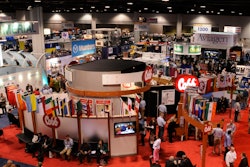As you drive west on U.S. highway 2 in Northeastern Montana, you’ll begin to make out an enormous grain elevator on the horizon, amongst the oil wells that dot the Bakken oil field landscape. Impressive by all accounts, this high-capacity, state-of-the-art, highly automated loop track facility in Culbertson, MT, is strategically the only shuttle train facility within a 40-mile radius.
But despite its isolation, it is hardly one-of-a-kind. In fact, it is only one of a set of nearly identical triplet United Grain Corp. facilities that came online this summer. Prior to 2011, UGC had a partner who originated almost its entire wheat base. But as the amicable dissolving of the relationship drew nearer, UGC began planning for another way to secure its position as one of the leading two wheat exporters in the Pacific Northwestern United States. UGC’s leadership decided that in order to supply its Vancouver, WA, port facility with a steady supply stream, they would need to invest in not just one or two, but three 1-million-bushel loop track shuttle loading facilities.
After diligent market research, a thorough analysis of the region and extensive site studies, they selected three locations: Culbertson, MT, Conrad, MT, and Bucyrus, ND. Building three identical facilities allowed UGC and plant builder Younglove Construction LLC to streamline their equipment selections and incorporate many efficiencies throughout the design and construction phases.
But while the three facilities run the same equipment and were built exactly alike, one site stands out among the rest: Culbertson, MT. This location will soon be home to an adjoining sand facility with shared access to the loop track and additional ladder tracks on site for rail car storage. Its location at the base of the Bakken oil field — where a modern day “Gold Rush” has enveloped the region — afforded UGC the opportunity to develop a partnership with Fairmount Minerals, one of the leading providers of sand to nearby oil fracking wells. The partnership not only eased some of the burden of financing such a large project, but it will also allow UGC to maximize its staff, who are contracted to eventually man and run the sand facility once construction is complete.
With a combined capacity of 3 million bushels, the new facilities are an integral part of UGC’s origination base, and have poised the company to meet its demand for years to come.
Three’s a crowd
They say when searching for property, the key factors are: location, location, location! The fact that UGC was siting three facilities makes the saying all the more appropriate. Which is why Tony Flagg, vice president of business development for UGC, says that when they began planning their new facilities in 2010, the region’s crop growing characteristics played a huge role in site selection.
“We wanted a modern shuttle train facility in each of the three major wheat growing areas that service the Pacific Northwest market,” says Flagg. “Conrad is in the middle of the triangle, the area north of Great Falls, MT, which is a prime growing area for Hard Red Winter Wheat. Culbertson is in the middle of the northeast corner of Montana and the northwest corner of North Dakota — a major growing area for Spring Wheat and Durham. Bucyrus encompassed the third area we wanted to target: the southwest corner of North Dakota, which is known for very high quality Spring Wheat.”
Once the locations were selected, construction on the Culbertson facility began in April 2011, the Conrad facility began in August 2011 and the Bucyrus facility began in January 2012. Despite their varied starting points, all three eight-pack facilities came online within a month of each other in late summer 2013. Dave Toel, project manager at Younglove Construction LLC, points out that their streamlined approach to design, facility layout and equipment helped the jobs go smoothly and stay on schedule.
Throughout the design phase, the team planned building solutions that could be applied to all three. For example, flooding is a problem in North Dakota, while Montana is plagued with soil condition issues. To combat both, all the processes and equipment (besides the receiving conveyors) were built above grade without any underground tunnels. As an added bonus, this layout makes for easy construction and maintenance because workers do not have to enter a confined space to service them. Toel says the advantages of building three facilities at once came to surface throughout the entire project.
“The sites are identical, so once we selected a piece of equipment, the decision was made for all three,” says Toel. “This helped during construction because there was no need for retraining workers when they moved from one facility to the next. Our labor force was very efficient by the time the third facility was being built.”
Workflow and lay out
Brian Wixom, UGC regional manager and Culbertson facility manager, says the facilities follow a fairly standard workflow. Wheat comes in by truck, is sampled with a probe and brought into the elevator from the platform scale. From there, it is tested for protein and moisture and graded. The data is entered into its routing software system, and from there the process is automated.
The wheat drops into a receiving pit where it hits a 25,000 bushel/hour conveyor. From there, it dumps into the receiving leg, and travels up onto another conveyor that distributes the grain across the top of the elevator. The automation program opens one of the 11 gates above the elevator and empties the commodity into the correct bin.
On the reclaim side, a 50,000 bushel/hour roller belt conveyor travels the entire length of the elevator. Commodity directly dumps into the belt conveyor from the four slip-formed concrete bins on one side of the eight-pack, while contents from the four bins on the other side and three intersplices come over to the conveyor on a 50,000 bushel/hour chain drag conveyor.
“We can come out of any bin or combination of bins at full speed,” Wixom proudly remarks.
Once it leaves the bin, commodity enters the automated shipping process via a 50,000 bushel/hour elevator leg. From there, it goes directly out to rail, where a bulk weigher sits over the 120-car-loop-track.
For the time being, the BNSF railroad delivers 110 car trains to the facility, but the track was built to accommodate an additional 10 rail cars for future expansion.
Designed to load 110 rail cars in 10 hours, Wixom notes it can be done even quicker. “The improvements in automation systems throughout the 2000s have really changed everything for grain elevators,” says Wixom. “Today, in 10 hours we can load what once took us three days 15 years ago.”
Automation advantage
Located in the sparsely populated “big sky country,” companies have to make the most of their labor force. So with that in mind, UGC and Younglove Construction worked from conceptual design to utilize automation controls and avoid manual operations.
“They have systems in place to run everything from opening electric gates to turning on conveying equipment at the right time and routing the grain to the right destination via computer controls,” says Younglove’s Toel.
Taking operations out of human hands helps Wixom run the facility with a razor thin staff that is both highly productive and effective. “On a very busy day it might take three operators to run receiving, but on days we're not going full speed, we can handle it with two people,” Wixom boasts. “At full speed, one person will run the scale and track the weights, while another runs the sample and the third will man the dump pit. We can dump a tremendous amount of wheat with very little manpower.”
But it’s not all about labor savings. In fact, Wixom says the main advantage of automation is keeping their freight rates low and being able to pass the savings on to their customers.
“The idea is not so much to have fewer employees, but efficiency in terms of shipping costs,” says Wixom. “As long as we keep those trains moving as quickly as possible, that keeps the freight rates down, and that goes right back to the producer in the form of lower freight rates. And that’s why you’ll continue to see this evolution in the grain industry toward state-of-the-art high-speed shuttle facilities.”
However, the grain isn’t the only one utilizing the BNSF rail line in Northeastern Montana. The expanding oil industry in the Bakkens has dramatically increased the demand for sand, which is needed to extract crude oil from the ground through hydraulic fracturing — or fracking. UGC identified this industry as a business opportunity and began designing the Culbertson facility’s loop track for dual purposes: sand and grain.
Shared vision
UGC leadership visited Culbertson in 2010 to scout the area and quickly came to the conclusion that railroad tracks could easily be used there for more than just grain. The idea became one of the key decision factors in selecting the Culbertson site.
“Railroad tracks cost several million dollars to build, so if you're in the grain business and you only handle three to five trains a month during some parts of the year, it's hard to justify that investment,” says Flagg. “But if they can serve a dual purpose, whether that be unloading frack sand on an inbound basis to support the oil wells, or loading out oil on an outbound basis, the ability to be supported by another industry helps justify the expense.”
Before a partner was even secured, the design team took a departure from its three-of-a-kind approach and expanded Culbertson’s loop track to hold 120 rail cars and built additional straight track so there would be enough room for a future sand facility receiving pit. In July 2012, UGC found their match and formed a partnership with Fairmount Minerals, who now owns the land adjacent to the grain elevator with plans to build their own facility.
Flagg explains how the sand operations at UGC Culbertson will work once the facility and track are complete. “In order to support Fairmount Minerals, the facility will have ladder tracks as an extension of the loop track. Once completed, they’ll hold 92 rail cars. The cars will come in full of sand and sit on the ladder tracks where a transloader will directly transfer the sand to trucks for shipping out to the oil wells.”
While Fairmount Minerals will own the ladder track and the sand transfer operation, UGC has secured an operating contract with Fairmount, allowing them to utilize their work force to both companies’ advantages. When the two facilities are fully operational, the site will require only six to eight full time employees, according to Flagg.
“One day they may be loading trucks with sand and the next day he may be loading grain cars, so we've got more flexibility in terms of utilization of the work force by having this other activity at Culbertson,” says Flagg.
Wixom is optimistic about the future of the partnership.
“I think it's a great way to use our investment to enhance its value,” he says. “Being a part of the grain industry and involved in the oil industry is really the best way to take advantage of all the natural assets the area offers.”



















